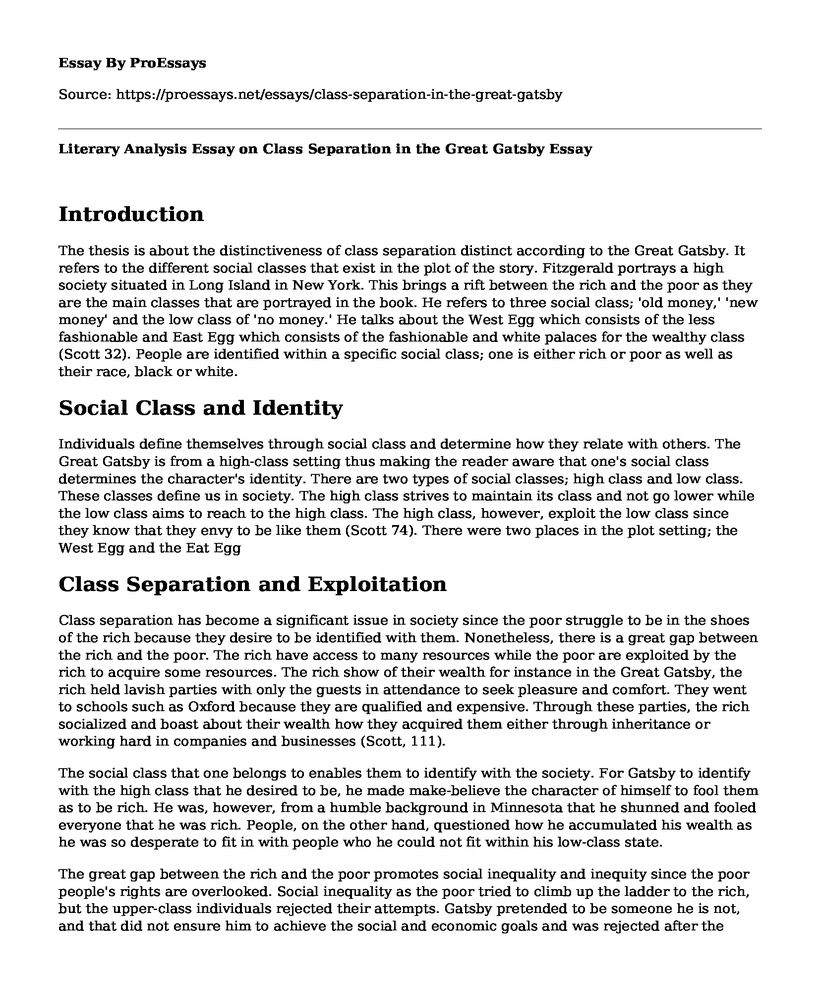Introduction
The thesis is about the distinctiveness of class separation distinct according to the Great Gatsby. It refers to the different social classes that exist in the plot of the story. Fitzgerald portrays a high society situated in Long Island in New York. This brings a rift between the rich and the poor as they are the main classes that are portrayed in the book. He refers to three social class; 'old money,' 'new money' and the low class of 'no money.' He talks about the West Egg which consists of the less fashionable and East Egg which consists of the fashionable and white palaces for the wealthy class (Scott 32). People are identified within a specific social class; one is either rich or poor as well as their race, black or white.
Social Class and Identity
Individuals define themselves through social class and determine how they relate with others. The Great Gatsby is from a high-class setting thus making the reader aware that one's social class determines the character's identity. There are two types of social classes; high class and low class. These classes define us in society. The high class strives to maintain its class and not go lower while the low class aims to reach to the high class. The high class, however, exploit the low class since they know that they envy to be like them (Scott 74). There were two places in the plot setting; the West Egg and the Eat Egg
Class Separation and Exploitation
Class separation has become a significant issue in society since the poor struggle to be in the shoes of the rich because they desire to be identified with them. Nonetheless, there is a great gap between the rich and the poor. The rich have access to many resources while the poor are exploited by the rich to acquire some resources. The rich show of their wealth for instance in the Great Gatsby, the rich held lavish parties with only the guests in attendance to seek pleasure and comfort. They went to schools such as Oxford because they are qualified and expensive. Through these parties, the rich socialized and boast about their wealth how they acquired them either through inheritance or working hard in companies and businesses (Scott, 111).
The social class that one belongs to enables them to identify with the society. For Gatsby to identify with the high class that he desired to be, he made make-believe the character of himself to fool them as to be rich. He was, however, from a humble background in Minnesota that he shunned and fooled everyone that he was rich. People, on the other hand, questioned how he accumulated his wealth as he was so desperate to fit in with people who he could not fit within his low-class state.
The great gap between the rich and the poor promotes social inequality and inequity since the poor people's rights are overlooked. Social inequality as the poor tried to climb up the ladder to the rich, but the upper-class individuals rejected their attempts. Gatsby pretended to be someone he is not, and that did not ensure him to achieve the social and economic goals and was rejected after the truth was discovered. He was said to have been selling illegal alcohol thus acquiring his wealth (Scott 96). The upper class does not respect the working class as the working class supports them. The upper class goes for luncheons and parties, i.e. Daisy and Jordan Baker while the lower classes work so hard and never reach their goals.
Conclusion
In conclusion, class separation is rampant in the book, and it is seen especially with how they are called, old money, new money, and no money. The geographical situation of the people also sees it; the upper class lived in East Egg while the low class lived in West Egg which was opposite one another. The poor are rejected when they aim to achieve riches, and if their means of wealth are not authentic, then they are dismissed in the economic and social goals. The poor go to the extent of pretending to be rich to be in the shoes of the rich. Therefore, social class separation has created a huge gap between the rich and the poor.
Work Cited
Scott, Fitzgerald. The Great Gatsby. Charles Scribner's Son .1925
Cite this page
Literary Analysis Essay on Class Separation in the Great Gatsby. (2022, Feb 12). Retrieved from https://proessays.net/essays/class-separation-in-the-great-gatsby
If you are the original author of this essay and no longer wish to have it published on the ProEssays website, please click below to request its removal:
- I Know Why the Caged Bird Sings
- Common Sense by Thomas Paine - Literary Essay Sample
- Intertwining Autobiographical Events in A Farewell to Arms
- Violence in Elkins' Imperial Reckoning Essay Example
- Harry Potter and the Philosopher's Stone Essay
- Male Friendship According to Tobias Wolff Essay Example
- Paper Example on The Iliad and Odyssey: A Tale of Latecomers From the East







